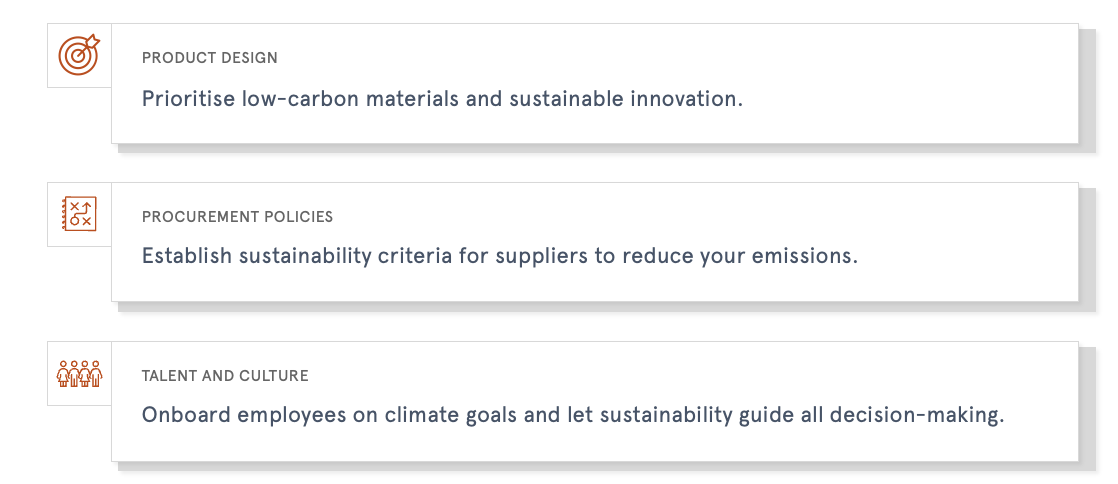
This is the second piece of a three-part series following our webinar “Crafting a credible climate transition plan”.
A transition plan is essential for all organisations shifting to a low-carbon economy, positioning them for long-term stability and resilience. In this guide, we will walk you through how to successfully build one, step by step. Building on our previous article on what a climate transition plan (CTP) is, we now turn to the practicalities.
Seven steps for a robust climate transition plan

Step 1: Measure your current emissions
A credible climate transition plan begins with a thorough assessment of your company’s greenhouse gas (GHG) emissions. These emissions include direct emissions from company-owned or controlled sources (Scope 1), indirect emissions from purchased electricity (Scope 2), and emissions from the entire value chain (Scope 3).
You also need to identify carbon hotspots within operations and supply chains, as well as use science-based methodologies to assess potential future climate risks and opportunities.
Step 2: Set Science-Based Targets
Your plan should be guided by internationally recognised standards, such as the Science-Based Targets initiative (SBTi), which ensures alignment with the Paris Agreement’s 1.5°C goal. A good approach to SBTi setting is developing both a net-zero target by 2050 and near-term targets, with intermediate milestones for 2030 and 2040.
Moreover, there is an evolving regulatory landscape that is increasingly demanding large companies to set credible climate targets, especially in the EU.
Step 3: Define pathways to achieve targets
Once the targets are set, the next step is to determinate actionable pathways to achieve them. For example, your company could investigate strategies on how to:
- Enhance operational efficiency
Upgrade to energy-efficient processes and technologies to reduce emissions within Scope 1 and 2, as well as operational waste included in Scope 3. - Transition to renewable energy
A shift to wind, solar, or other renewable energy sources will result in a reduction of your Scope 2 emissions. - Engage the supply chain
Encourage suppliers to decarbonise their operations to lower emissions in your own value chain (Scope 3). - Innovate the business model
Explore circular economy models and low-carbon products. This will not only reduce your emissions but make your company more resilient against supply chain disruptions. - Invest in carbon offsets
As a last resort, invest in credible carbon offset programs.
Step 4: Anchor climate strategy in operations
A credible CTP embeds climate considerations into core business functions, a crucial step which determines its success or failure. So, to ensure success, prioritise low-carbon materials, set sustainability criteria for suppliers and onboard all employees on your company’s climate goals.

Step 5: Integrate financial planning
A CTP must include budgeting for climate initiatives. This includes identifying necessary investments for decarbonisation efforts, including both OPEX and CAPEX.
Additionally, perform a risk analysis evaluating potential transition and physical risks (e.g., carbon pricing, market shifts). If your company has developed a Double Materiality Assessment (DMA), you can use that as a baseline for prioritisation in your Climate Risk Assessment.
Lastly, funding mechanisms are crucial. Explore green bonds, sustainability-linked loans, or internal investments, such as Internal Carbon Pricing (ICP).
Step 6: Secure leadership buy-in and governance
An effective CTP requires leadership onboarding and commitment. This involves:
- Ensuring accountability by assigning responsibility for climate strategy at executive and board level.
- Linking executive compensation to climate targets performance.
- Establishing clear governance structures such as cross-functional teams to drive implementation.
Step 7: Monitor, report and adapt
Climate strategies must be dynamic, responding to evolving policies, technologies, and market conditions. Best practices therefore include regular progress tracking, using key performance indicators (KPIs) aligned with SBTi targets and your CTP-specific initiatives.
Transparent reporting involves disclosing progress in sustainability reports and aligning with the latest legislative requirements, while iterative improvement entails updating strategies based on new climate data and business developments.

Turning strategy into action
This article has guided you through the seven steps to building a CTP, showing why a transition plan is essential for business strategy and long-term success.
In short, understanding your starting point, setting SBTs, identifying key decarbonisation levers, and integrating climate strategies into financial and governance frameworks will help you transition to a low-carbon future while maintaining a competitive edge.
Success requires an adaptive, transparent, and well-integrated approach. If you are unsure where to start your decarbonisation journey or need support in developing your CTP, our team has guided numerous companies through the process.
Reach out to our Climate Lead to learn more: Ole Høy Jakobsen.
Nordic Sustainability can help you with:
- Creating your first, or improving on your existing GHG inventory
- Helping you set science-based targets and get your targets validated
- Designing tailored climate transition plans that accelerate progress
- Integrating climate action into core operations and corporate governance



